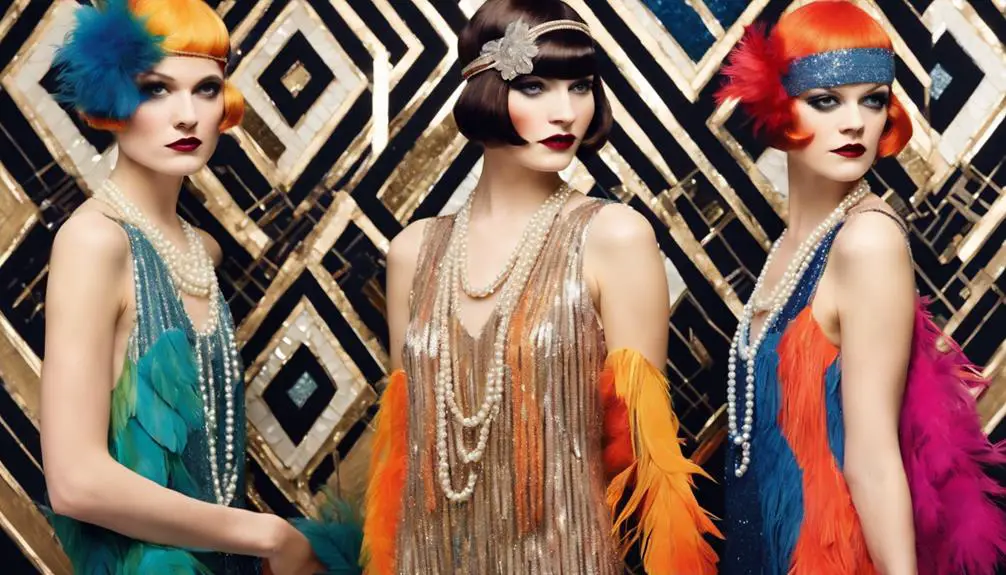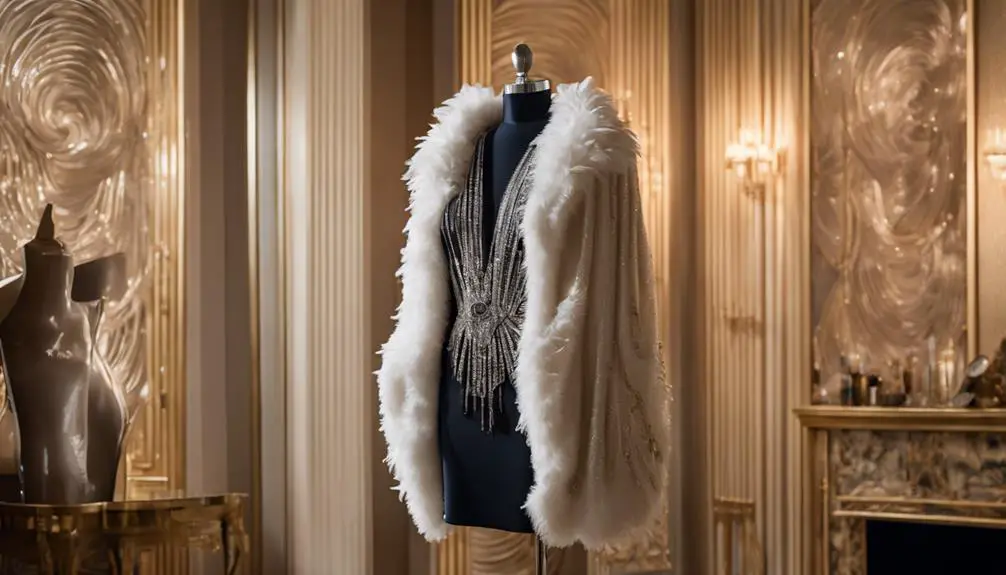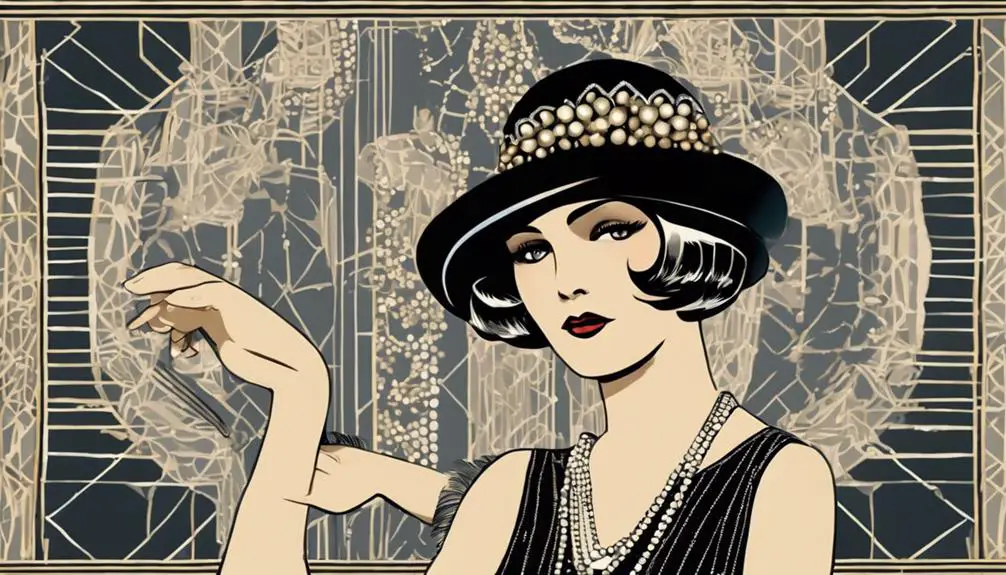You might think 1920s fashion is just about flapper dresses and bobbed hair, but there's much more to explore. This era marked a significant shift in style, with pieces that not only defined the decade but also reflected broader social changes. From the rise of the chemise to the influence of groundbreaking designers, each element tells a unique story about individuality and liberation. Consider how these iconic items still resonate today—what does that say about our current fashion choices?
Flapper Dress Evolution

The flapper dress stands as a bold emblem of the 1920s, embodying the era's spirit of liberation and change. This iconic garment emerged as a symbol of women's liberation, featuring a dropped waist and a straight, loose silhouette that typically fell to the knee. Such design allowed for unparalleled freedom of movement, a stark contrast to the restrictive corsets of previous decades.
Designers like Coco Chanel and Paul Poiret played pivotal roles in popularizing this revolutionary style, infusing it with decorative elements like rhinestones, fringe, and beadwork that gave flapper dresses their glamorous flair, particularly for evening wear.
As you embrace the essence of the Jazz Age, you'll notice how the flapper dress often accompanied accessories like long pearl necklaces and cloche hats, enhancing its playful and modern appeal. The androgynous look aligned with the La Garçonne movement, advocating for a boyish silhouette that challenged traditional femininity. This bold choice not only celebrated women's independence but also marked a notable shift in societal norms.
The evolution of the flapper dress considerably influenced subsequent fashion trends, laying the groundwork for more relaxed and practical styles that emerged in the following decades.
It's a reflection of how fashion can serve as a vehicle for social change, celebrating the spirit of freedom and individuality that defined an era. So, immerse yourself in the world of flapper fashion, and let its vibrant history inspire your own sense of style!
The Rise of the Chemise
In the 1920s, the chemise emerged as a revolutionary undergarment, replacing the restrictive corsets and petticoats that had dominated women's fashion for decades. This loose-fitting piece signaled a cultural shift towards comfort, allowing women to embrace their bodies and express their individuality. Made from luxurious fabrics like satin and silk crepe de chine, chemises featured lovely details such as Chantilly lace and floral embroideries, enhancing their appeal and sophistication.
The chemise became a fundamental component of the iconic flapper silhouette, which favored tubular shapes and androgynous lines rather than the hourglass figure of previous eras.
Here are four reasons why the chemise was so essential in 1920s women's fashion:
- Comfort: Unlike corsets, the chemise provided a relaxed fit, allowing for unrestricted movement.
- Versatility: This versatile undergarment could be worn alone or layered, adapting to various fashions and occasions.
- Stylish Appeal: With its elegant materials and intricate details, the chemise exuded a sense of luxury and refinement.
- Personal Expression: The chemise empowered women to choose how they showcased their bodies, reflecting a newfound freedom in style and self-presentation.
In essence, the rise of the chemise not only redefined undergarments but also played an essential role in shaping the bold, expressive women's fashion of the 1920s, making it a truly iconic fashion piece of the era.
Statement Cocoon Coats

Embracing dramatic flair and luxurious comfort, statement cocoon coats became a hallmark of 1920s fashion. Designed to envelop you in sumptuous materials like crushed velvet or fur, these coats provided not just warmth but also a striking style that turned heads. Paul Poiret played an essential role in popularizing the cocoon coat, emphasizing its voluminous shape and bold collars. This iconic design created a stunning contrast to the lightweight, short dresses that flappers favored, making it a perfect complement to the liberated spirit of the flapper movement.
As you explore the 1920s, you'll notice that cocoon coats often featured intricate embellishments, adding a touch of glamour to your outfit. Crafted from opulent fabrics, they were more than just outerwear; they were a fashion statement that combined utility with elegance.
The voluminous shape allowed for freedom of movement, making these coats ideal for socializing and dancing during the vibrant Jazz Age. Imagine yourself at a lively soirée, twirling on the dance floor, your cocoon coat swaying gracefully around you.
The elegance of the coat not only keeps you warm but also enhances your overall look, ensuring you stand out in the crowd. With the cocoon coat as your go-to piece, you can effortlessly embody the spirit of the 1920s, showcasing your appreciation for both comfort and style.
Timeless Long Pearl Necklaces
Long pearl necklaces emerged as a defining accessory of 1920s fashion, effortlessly combining elegance with accessibility. These stunning pieces symbolize sophistication, thanks to advances in artificial pearl production that made them attainable for a broader audience.
The versatility of long pearl necklaces allowed you to express your style in various ways, making them essential for every wardrobe.
Here are four ways to wear long pearl necklaces:
- Layering: Combine multiple strands for a chic, textured look that adds depth to your outfit.
- Knotting: Create an eye-catching knot at the front or side for a playful twist, perfect for the flapper style.
- Draping: Let the necklace hang loosely for a relaxed elegance that complements the flowing silhouettes of the decade.
- Geometric accents: Choose pieces that incorporate Art Deco elements, such as bold colors and geometric shapes, to elevate your ensemble.
Long pearl necklaces beautifully enhanced the overall look of 1920s fashion, perfectly pairing with the loose silhouettes of flapper dresses.
They captured the liberated spirit of the era, allowing women to embrace their newfound freedom with grace. Whether you wore them for daytime outings or glamorous evening events, these timeless fashion statements remain a symbol of elegance and sophistication even today.
Influential Designers of the Era

The influential designers of the 1920s transformed the fashion landscape, bringing forth styles that celebrated both freedom and femininity. Coco Chanel led the charge by popularizing the flapper dress, a symbol of liberation that allowed women to move freely and express their individuality.
Her creation of the iconic Little Black Dress (LBD) further revolutionized women's wardrobes, proving that elegance could coexist with comfort.
Paul Poiret was another key figure, liberating women from the constraints of corsets with his innovative "freedom dress." He embraced bold designs, including the luxurious cocoon coat, which showcased volume and artistry, reflecting the era's opulence.
Meanwhile, Elsa Schiaparelli captivated fashion enthusiasts with her daring use of bold colors and surrealistic motifs, challenging conventional aesthetics and solidifying her place alongside Chanel.
Her designs inspired a wave of creativity, making her a staple in the fashion discourse of the time.
Madeleine Vionnet brought a technical edge to 1920s fashion with her revolutionary bias cut, allowing fabrics to flow gracefully and hug the body in a way that highlighted feminine curves.
Her artistic approach to cutting was a game changer, emphasizing the beauty of movement.
Vogue Magazine played an essential role in disseminating these fashion trends, showcasing the work of these extraordinary designers and shaping public perceptions of style.
Together, these influential figures crafted a vibrant and dynamic fashion era that continues to inspire designers today.



Fantastic site you have here but I was wanting to know if you knew of any message boards that cover the same topics talked about here?
I’d really love to be a part of group where I can get feed-back from other knowledgeable
people that share the same interest. If you have any
suggestions, please let me know. Kudos!
Hi, i feel that i saw you visited my website thus i got here to go back the
want?.I am trying to find things to enhance my website!I
guess its adequate to use a few of your ideas!!
Wonderful blog! I found it while surfing around on Yahoo News.
Do you have any suggestions on how to get listed in Yahoo News?
I’ve been trying for a while but I never seem to get there!
Cheers
You’re so cool! I don’t think I have read a single thing like that before.
So nice to discover somebody with a few unique thoughts on this subject matter.
Really.. thanks for starting this up. This site is something that is required on the
internet, someone with some originality!
350fairfax nordvpn
I blog quite often and I truly appreciate your information. The article has
truly peaked my interest. I am going to bookmark your site
and keep checking for new details about once a week.
I opted in for your Feed too.
Hello there! I know this is kinda off topic but I’d figured I’d ask.
Would you be interested in exchanging links or maybe guest authoring a
blog post or vice-versa? My website goes
over a lot of the same topics as yours and I believe we could greatly
benefit from each other. If you happen to be interested feel free to shoot me an e-mail.
I look forward to hearing from you! Fantastic blog by the way!
For latest information you have to pay a visit world-wide-web and on web I found this web page as a best website for newest updates.
Thank you for the good writeup. It in fact was a amusement account it.
Look advanced to far added agreeable from you! By the way,
how can we communicate? gamefly free trial https://tinyurl.com/2ah5u2sb
Having read this I believed it was extremely informative.
I appreciate you spending some time and effort to put
this informative article together. I once again find
myself personally spending a lot of time both reading and posting comments.
But so what, it was still worth it! Vpn explained https://tinyurl.com/2xsenm6a
If you wish for to obtain a good deal from this post then you have to apply these methods
to your won weblog.
Hurrah! After all I got a weblog from where I know how to really take helpful data regarding my
study and knowledge.
I’ve been surfing online more than 3 hours today, yet I never found
any interesting article like yours. It is pretty worth enough for me.
In my opinion, if all web owners and bloggers made good content as you did,
the internet will be much more useful than ever before.
Eharmony special coupon code 2025 https://tinyurl.com/2xd9hovp
What’s up, ju?t wanted to mention, I enjoyed this blog post.
It was funny. ?ee? on posting!
I ?o not know whether it’s just me o? if ??rhaps everyone else experiencing ?roblems with your website.
It appears a? though some of th? ?r?tten text in your popsts are
running off the screen. Can ?omebody else plezse comment and
let me know ?f this ?s happening to them as ?ell?
Thhis may be a problem with my w?b browser because I’ve had this happen previously.
Thanks
Hi, I think your site might be having web browser compatibility problems.
Whenever I take a look at your website in Safari, it looks fine however, when opening in I.E., it’s got some overlapping
issues. I simply wanted to provide you with a quick heads up!
Aside from that, fantastic blog!
I don’t even know how I finished up right here, but I believed this publish used to
be good. I don’t know who you are however certainly you are going to a famous blogger
for those who aren’t already. Cheers!
papamasque – I admire their subtle style, it’s refined yet boldly expressive.
Thanks for your post. I would also love to say that the health insurance brokerage service also works for the benefit of the actual coordinators of any group insurance plan. The health agent is given a listing of benefits wanted by someone or a group coordinator. Exactly what a broker can is seek out individuals and also coordinators which in turn best complement those demands. Then he presents his referrals and if all sides agree, the actual broker formulates an agreement between the 2 parties.